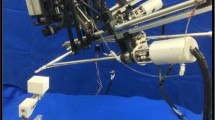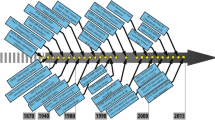Abstract
Background
Round trip signal latency, or time delay, is an unavoidable constraint that currently stands as a major barrier to safe and efficient remote telesurgery. While there have been significant technological advancements aimed at reducing the time delay, studies evaluating methods of mitigating the negative effects of time delay are needed. Herein, we explored instrument motion scaling as a method to improve performance in time-delayed robotic surgery.
Methods
This was a robotic surgery user study using the da Vinci Research Kit system. A ring transfer task was performed under normal circumstances (no added time delay), and with 250 ms, 500 ms, and 750 ms delay. Robotic instrument motion scaling was modulated across a range of values (− 0.15, − 0.1, 0, + 0.1, + 0.15), with negative values indicating less instrument displacement for a given amount of operator movement. The primary outcomes were task completion time and total errors. Three-dimensional instrument movement was compared against different motion scales using dynamic time warping to demonstrate the effects of scaling.
Results
Performance declined with increasing time delay. Statistically significant increases in task time and number of errors were seen at 500 ms and 750 ms delay (p < 0.05). Total errors were positively correlated with task time on linear regression (R = 0.79, p < 0.001). Under 750 ms delay, negative instrument motion scaling improved error rates. Negative motion scaling trended toward improving task times toward those seen in non-delayed scenarios. Improvements in instrument path motion were seen with the implementation of negative motion scaling.
Conclusions
Under time-delayed conditions, negative robotic instrument motion scaling yielded fewer surgical errors with slight improvement in task time. Motion scaling is a promising method of improving the safety and efficiency of time-delayed robotic surgery and warrants further investigation.





Similar content being viewed by others
Change history
21 July 2020
A Correction to this paper has been published: https://doi.org/10.1007/s00464-020-07825-9
References
Satava RM (2003) Robotic surgery: from past to future—a personal journey. Surgical Clinics 83:1491–1500
Green PS, Hill JW, Jensen JF, Shah A (1995) Telepresence surgery. IEEE Eng Med Biol Mag 14:324–329
Madhani AJ, Niemeyer G, Salisbury JK (1998) The black falcon: a teleoperated surgical instrument for minimally invasive surgery. In: Proceedings. 1998 IEEE/RSJ international conference on intelligent robots and systems. Innovations in theory, practice and applications (Cat. No. 98CH36190), IEEE, pp 936–944
Taylor RH, Funda J, Eldridge B, Gomory S, Gruben K, LaRose D, Talamini M, Kavoussi L, Anderson J (1995) A telerobotic assistant for laparoscopic surgery. IEEE Eng Med Biol Mag 14:279–288
Marescaux J, Leroy J, Gagner M, Rubino F, Mutter D, Vix M, Butner SE, Smith MK (2001) Transatlantic robot-assisted telesurgery. Nature 413:379
Anvari M, McKinley C, Stein H (2005) Establishment of the world's first telerobotic remote surgical service: for provision of advanced laparoscopic surgery in a rural community. Ann Surg 241:460
Niemeyer G, Preusche C, Stramigioli S, Lee D (2016) Telerobotics. Springer, New York, pp 1085–1108
Kazanzides P, Chen Z, Deguet A, Fischer GS, Taylor RH, DiMaio SP (2014) An open-source research kit for the da Vinci® Surgical System. In: 2014 IEEE international conference on robotics and automation (ICRA), IEEE, pp 6434–6439
Salvador S, Chan P (2007) Toward accurate dynamic time warping in linear time and space. Intell Data Anal 11:561–580
O'sullivan S, Nevejans N, Allen C, Blyth A, Leonard S, Pagallo U, Holzinger K, Holzinger A, Sajid MI, Ashrafian H (2019) Legal, regulatory, and ethical frameworks for development of standards in artificial intelligence (AI) and autonomous robotic surgery. Int J Med Robot Comput AssistSurg 15:e1968
Yip M, Das N (2018) Robot autonomy for surgery. The encyclopedia of medical robotics. World Scientific, Singapore, pp 281–313
The Society of American Gastrointestinal and Endoscopic Surgeons. Guidelines for the Surgical Practice of Telemedicine. https://www.sages.org/wp-content/uploads/wp-post-to-pdf-enhanced-cache/1/guidelines-for-the-surgical-practice-of-telemedicine.pdf. Accessed 26 Jan 2020.
Xu S, Perez M, Yang K, Perrenot C, Felblinger J, Hubert J (2014) Determination of the latency effects on surgical performance and the acceptable latency levels in telesurgery using the dV-Trainer((R)) simulator. Surg Endosc 28:2569–2576
Kapoor A, Kumar R, Taylor RH (2003) Simple biomanipulation tasks with "steady hand" cooperative manipulator. Lecture Notes Comput Sci 2878:141–148
Schweikard A, Tombropoulos R, Kavraki L, Adler JR, Latombe JC (1994) Treatment planning for a radiosurgical system with general kinematics. In: IEEE International Conference on Robotics and Automation, pp 1720–1727
Kumcu A, Vermeulen L, Elprama SA, Duysburgh P, Platisa L, Van Nieuwenhove Y, Van De Winkel N, Jacobs A, Van Looy J, Philips W (2017) Effect of video lag on laparoscopic surgery: correlation between performance and usability at low latencies. Int J Med Robot Comp 13(2):e1758
Kim T, Zimmerman P, Wade M, Weiss C (2005) The effect of delayed visual feedback on telerobotic surgery. Surg Endosc Other Interv Tech 19:683–686
Kumcu A, Vermeulen L, Elprama SA, Duysburgh P, Platiša L, Van Nieuwenhove Y, Van De Winkel N, Jacobs A, Van Looy J, Philips W (2017) Effect of video lag on laparoscopic surgery: correlation between performance and usability at low latencies. Int J Med Robot Comput Assist Surg 13:e1758
Sterbis JR, Hanly EJ, Herman BC, Marohn MR, Broderick TJ, Shih SP, Harnett B, Doarn C, Schenkman NS (2008) Transcontinental telesurgical nephrectomy using the da Vinci robot in a porcine model. Urology 71:971–973
Perez M, Quiaios F, Andrivon P, Husson D, Dufaut M, Felblinger J, Hubert J (2007) Paradigms and experimental set-up for the determination of the acceptable delay in telesurgery. In: 2007 29th annual international conference of the IEEE engineering in medicine and biology society, IEEE, pp 453–456
Anvari M, Broderick T, Stein H, Chapman T, Ghodoussi M, Birch DW, Mckinley C, Trudeau P, Dutta S, Goldsmith CH (2005) The impact of latency on surgical precision and task completion during robotic-assisted remote telepresence surgery. Comput Aid Surg 10:93–99
Perez M, Xu S, Chauhan S, Tanaka A, Simpson K, Abdul-Muhsin H, Smith R (2016) Impact of delay on telesurgical performance: study on the robotic simulator dV-Trainer. Int J Comput Assist Radiol Surg 11:581–587
Ang WT (2004) Active tremor compensation in handheld instrument for microsurgery. Carnegie Mellon University, the Robotics Institute
Riviere CN, Gangloff J, De Mathelin M (2006) Robotic compensation of biological motion to enhance surgical accuracy. Proc IEEE 94:1705–1716
Becker BC, MacLachlan RA, Lobes LA, Hager GD, Riviere CN (2013) Vision-based control of a handheld surgical micromanipulator with virtual fixtures. IEEE Trans Robot 29:674–683
Rosenberg LB (1993) Virtual fixtures: perceptual tools for telerobotic manipulation. In: Proceedings of IEEE virtual reality annual international symposium, IEEE, pp 76–82
Park S, Howe RD, Torchiana DF (2001) Virtual fixtures for robotic cardiac surgery. In: International conference on medical image computing and computer-assisted intervention, Springer, New York, pp 1419–1420
Li M, Kapoor A, Taylor RH (2007) Telerobotic control by virtual fixtures for surgical applications. Advances in Telerobotics, Springer, pp 381–401
Rydén F, Chizeck HJ, Kosari SN, King H, Hannaford B (2011) Using kinect and a haptic interface for implementation of real-time virtual fixtures. In: Proceedings of the 2nd workshop on RGB-D: advanced reasoning with depth cameras (in conjunction with RSS 2011)
Li Y, Richter F, Lu J, Funk E, Orosco R, Zhu J, Yip MC (2020) SuPer: a surgical perception framework for endoscopic tissue manipulation with surgical robotics. IEEE Robot Autom Lett 5(2):2294–2301
Jacobs S, Holzhey D, Kiaii BB, Onnasch JF, Walther T, Mohr FW, Falk V (2003) Limitations for manual and telemanipulator-assisted motion tracking–implications for endoscopic beating-heart surgery. Ann Thorac Surg 76:2029–2035 (discussion 2035-2026)
Cassilly R, Diodato MD, Bottros M, Damiano RJ Jr (2004) Optimizing motion scaling and magnification in robotic surgery. Surgery 136:291–294
Prasad SM, Prasad SM, Maniar HS, Chu C, Schuessler RB, Damiano RJ Jr (2004) Surgical robotics: impact of motion scaling on task performance. J Am Coll Surg 199:863–868
Richter F, Orosco RK, Yip MC (2019) Motion Scaling Solutions for Improved Performance in High Delay Surgical Teleoperation. arXiv preprint arXiv:abs/190203290
Acknowledgements
We thank Eric D Wirtz MD and Kelly Groom MD and other participants from the user study for their time. We wish to acknowledge and thank all the members of the Advanced Robotics and Controls Lab at UC San Diego for the intellectual discussions and technical help. We also acknowledge Dale Bergman and the Intuitive Surgical Research Division for their technical support of our dVRK system. Thank you to the United States Army Medical Research and Material Command (USAMRMC) and Telemedicine and Advanced Technology Research Center (TATRC) for their support, and for the UC San Diego Altman Clinical and Translational Research Institute (ACTRI) Galvanizing Engineering and Medicine Award that supported this work.
Funding
Rapid Innovation Fund (RIF) Award—FY17 AMEDD Advanced Medical Technology Initiative (AAMTI), United States Army Medical Research and Material Command (USAMRMC), Telemedicine and Advanced Technology Research Center (TATRC). UC San Diego, Altman Clinical and Translational Research Institute (ACTRI) Galvanizing Engineering and Medicine Award.
Author information
Authors and Affiliations
Corresponding author
Ethics declarations
Disclosures
Robotic instruments for the dVRK were provided through a collaboration with Intuitive Surgical. The company did not have a role in the design, implementation, or interpretation of this study. This work was funded, in part, through a Rapid Innovation Fund (RIF) Award through the United States Army Medical Research and Material Command (USAMRMC) and Telemedicine and Advanced Technology Research Center (TATRC). The views expressed are those of the authors and do not reflect the official policy or position of the US Army, Department of Defense, or the US Government. Dr. Orosco reports non-financial support from Intuitive Surgical, grants from United States Army Medical Research and Material Command (USAMRMC), Telemedicine and Advanced Technology Research Center (TATRC), grants from UC San Diego—Altman Clinical and Translational Research Institute (ACTRI), during the conduct of the study; In addition, Dr. Orosco has a patent Motion scaling for time-delayed robotic surgery pending. Dr. Matsuzaki reports grants from Japan Society for the Promotion of Science, during the conduct of the study. Dr. Funk reports grants from NIH/NIDCD during the conduct of the study. Dr. Richter reports non-financial support from Intuitive Surgical, during the conduct of the study; In addition, Dr. Richter has a patent Motion scaling for time-delayed robotic surgery pending. Dr. Yip reports non-financial support from Intuitive Surgical, grants from United States Army Medical Research and Material Command (USAMRMC), Telemedicine and Advanced Technology Research Center (TATRC), grants from UC San Diego—Altman Clinical and Translational Research Institute (ACTRI), during the conduct of the study; In addition, Dr. Yip has a patent Motion scaling for time-delayed robotic surgery pending. The other authors have nothing to disclose.
Additional information
Publisher's Note
Springer Nature remains neutral with regard to jurisdictional claims in published maps and institutional affiliations.
This article was updated to correct Tokio Matsuzaki’s name in author listing.
Rights and permissions
About this article
Cite this article
Orosco, R.K., Lurie, B., Matsuzaki, T. et al. Compensatory motion scaling for time-delayed robotic surgery. Surg Endosc 35, 2613–2618 (2021). https://doi.org/10.1007/s00464-020-07681-7
Received:
Accepted:
Published:
Issue Date:
DOI: https://doi.org/10.1007/s00464-020-07681-7




